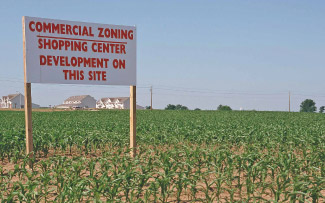Protect Washington farmland: Issues with Initiative-933
by Amy Kober
This article was originally published in October 2006

(October 2006) — Protecting working farmland from urban sprawl never has been easy, but it will become even harder if Initiative 933 passes in November.
Initiative 933 would create a “pay or waive” system that would force taxpayers either to pay off certain people to follow laws that already are on the books, or make local communities waive those protections.
Picture this scenario: a developer wants to build a massive new shopping mall in the middle of land zoned for agriculture. Under I-933, if the surrounding community wants to protect the farmland and stop the development, taxpayers would have to pay the developer the value of the unbuilt mall. If the cash-strapped local government can’t afford to pay, it would have to waive the farmland protections and let the development go forward.
I-933 would cost hundreds of millions in taxpayer dollars just to administer, and billions of dollars to pay off claims. Because of the high cost, local communities would be forced to waive local land and community protections — creating major loopholes for irresponsible development.
I-933 poses an especially dangerous threat to the long-term viability of farming in Washington. I-933 would require counties to waive reasonable limits on the number of homes that can be built in agricultural zones. These new subdivisions likely would interfere with normal farming practices due to complaints about smells, dust and noise.
Conflicts between encroaching suburban residents and farmers would escalate and in many places family farms and the rural lifestyle would simply disappear.
“This initiative starts a war farmers will lose when competing against developers for land that no longer receives the protection and stability ensured by current zoning and land-use regulations,” said Burlington farmer Steve Sakuma. “If this initiative passes, it will be a field day for attorneys and land speculators for many years to come.”
The Skagit Valley Herald recently editorialized, “If I-933 is approved by voters and fully implemented as intended, the scenery will change dramatically. When the dominoes start to fall, you can kiss farming good-bye in Skagit County.”
Alarmed by the threat this initiative poses to farmland protection, locally grown food and a sustainable future, PCC Natural Markets has announced it’s opposed to I-933, along with other groups such as Tilth Producers of Washington, United Farm Workers, the Western Washington Agriculture Association, the PCC Farmland Trust, and Skagitonians to Preserve Farmland.
I-933 is sponsored by the Washington Farm Bureau (largely controlled by agribusiness), but out-of-state developers are the real force behind the initiative. A group chaired by a New York real estate developer donated $200,000 to pay for signatures to get I-933 on the ballot in Washington. That same developer has funneled at least $4 million through libertarian groups to similar initiatives in California, Idaho, Montana, Nevada and Arizona.
It all began in Oregon, where Measure 37 passed in 2004. Since then, more than 2,900 claims have been filed across the state seeking nearly $4 billion in compensation. Protections have been waived in 90 percent of the claims – mostly involving farmland. Penny Cox, a farmer in Polk County, Ore., called Measure 37 “every farmer’s nightmare.”
After the measure passed, the county’s board of commissioners approved a claim for one million feet of commercial space (the size of a large shopping center) on nearby farm and forest land. “Our lifetime investment can be wiped out overnight,” Penny said. “Measure 37’s backers never told us it would lead to this kind of unplanned mega-development.”
While the consequences of Measure 37 are bad, the impacts of I-933 would be even worse. I-933 has been called “Measure 37 on steroids” because it is retroactive and doesn’t have a time limit for filing claims.
Even Washington farmers who would like to fine-tune some of the state’s environmental protections believe I-933 goes too far. “Although I can complain about our current regulations with the best of them, I cannot advocate making these wholesale changes,” said Steve Sakuma. “The future of agriculture is put at risk when taking this approach.”
Bob Hart, land protection committee chair for Skagitonians to Preserve Farmland and former Skagit County Commissioner, said that inequities regarding farmland protections should be corrected with a “legislative scalpel” rather than with I-933, which he calls “a blunt instrument with untold negative consequences for farmland protection.”
For more information on the “No on I-933” campaign, visit www.NoOn933.org.
